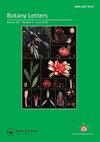我们对濒危植物的遗传多样性了解多少,关心多少?以法国植物区系为例
IF 1.3
4区 生物学
Q3 PLANT SCIENCES
引用次数: 0
摘要
人口规模小,遗传多样性降低,增加了种群灭绝的可能性。中性标记群体内的遗传多样性是一个启发式参数,因为它反映了过去和正在进行的作用于群体的过程,并告知可能的未来。本研究综合介绍了法国大城市受威胁植物中性遗传多样性的知识,并将这些数据用于管理行动。将受威胁物种与能找到合适遗传数据的最接近的非受威胁物种配对,收集了25种受威胁物种和非受威胁对照物种的遗传多样性信息。我们发现,在法国,受威胁物种的种群内遗传多样性平均低于未受威胁的对照组,因此面临与遗传侵蚀相关的风险。结合对恢复计划的分析和对从业者的调查,我们得出结论,遗传多样性很少被纳入管理行动。将这些信息整合到应用保护中仍然是一个挑战。本文为收集影响种群遗传多样性的生物学性状提供了一些指导原则,并为更好地将种群遗传学概念纳入保护行动提出了一些具体建议。本文章由计算机程序翻译,如有差异,请以英文原文为准。
How much do we know and how much do we care about genetic diversity of threatened plants ? A case study from the French flora
ABSTRACT Small demographic size and reduced genetic diversity increase the extinction probability of a population. Genetic diversity within populations for neutral markers is an heuristic parameter, as it reflects past and ongoing processes acting on populations, and informs on possible futures. This study presents a synthesis of the knowledge on neutral genetic diversity for threatened plants in metropolitan France and the use of such data in management actions. Pairing threatened species with the closest non-threatened species for which we could find appropriate genetic data, we collected information on genetic diversity for 25 threatened species and non-threatened controls. We found that threatened species in France have on average a lower within-population genetic diversity than non-threatened controls and thus are exposed to risks linked to genetic erosion. Combining an analysis of recovery plans and a survey addressed to practitioners, we concluded that genetic diversity is rarely integrated in management actions. The integration of such information into applied conservation remains a challenge. We provide some guidelines to collect biological traits impacting within-population genetic diversity and some specific recommendations for a better incorporation of population genetics concepts into conservations actions.
求助全文
通过发布文献求助,成功后即可免费获取论文全文。
去求助
来源期刊

Botany Letters
Agricultural and Biological Sciences-Plant Science
CiteScore
3.10
自引率
6.70%
发文量
54
期刊介绍:
Botany Letters is an international scientific journal, published by the French Botanical Society (Société botanique de France) in partnership with Taylor & Francis. Botany Letters replaces Acta Botanica Gallica, which was created in 1993, building on over a century of renowned publications by the Société botanique de France.
 求助内容:
求助内容: 应助结果提醒方式:
应助结果提醒方式:


